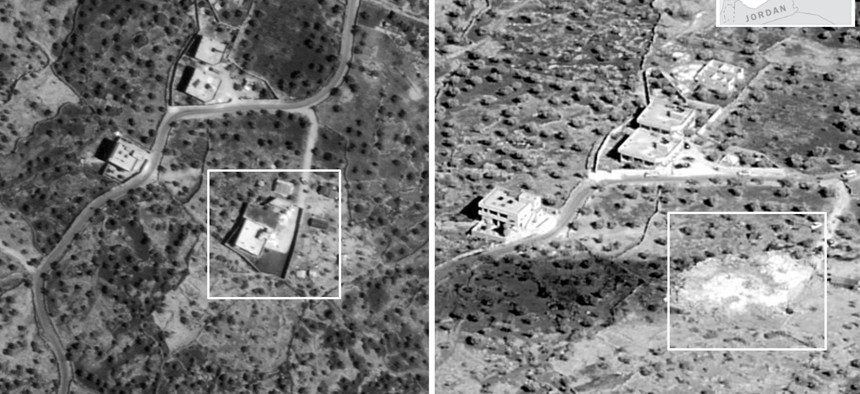
A side-by-side comparison of the compound before and after the raid. No collateral damage to adjacent structures Oct. 26, 2019. DOD Photo
General: Trump Pullout Did Not Affect Baghdadi Raid Timing
“We struck because the time was about right,” said CENTCOM’s Gen. Frank McKenzie, of intelligence and other factors.
President Trump’s abrupt decision to withdraw from Syria earlier this month had no impact on the timing or execution of the raid that killed ISIS leader Abu Bakr al-Baghdadi, the top general for American forces in the Middle East insisted.
“Absolutely not,” U.S. Central Command Gen. Ken McKenzie told reporters at the Pentagon on Wednesday. “We chose the time based on a variety of factors: weather, certainty, lunar data. While it might have been convenient to use bases [in Syria], the U.S. military has the capability to go almost anywhere and support ourselves even at great distances.”
“We struck because the time was about right to do it then given the totality of the intelligence and the other factors that would affect the raid force going in and coming out.”
Intelligence and military officials speaking to news outlets on background have claimed that Trump’s controversial Syrian withdrawal, which followed a phone call with Turkish President Recep Tayyip Erdogan, complicated the risky nighttime raid in northern Syria.
U.S. forces killed five other ISIS members inside the compound during the raid that killed ISIS leader Abu Bakr al-Baghdadi on Saturday, including four women and one man, according to the top general for American forces in the Middle East.
Baghdadi killed two children, not three as the president announced on Sunday, when he detonated his suicide vest rather than be captured by American troops who were closing in on him in a tunnel, told reporters at the Pentagon on Wednesday. Both children are believed to have been under the age of 12.
Helicopters supporting the mission also killed an unspecified number of fighters at two locations close to the compound where Baghdadi was hiding in northern Syria, after those fighters began firing on aircraft participating in the assault, McKenzie said. He said that the military does not believe those fighters were affiliated with Baghdadi. (Idlib province, where Baghdadi was killed, is dominated by a hodge-podge of extremist groups, including al-Qaeda.)
McKenzie walked through the timeline of the raid, launched by helicopter from a staging location an hour away in Syria, revealing new Defense Department pictures and aerial surveillance footage, including kill-shots from close-air support aircraft. But he provided just a handful of new details about a mission that he called “exquisitely planned and executed.”
Special operations forces surrounded the compound where Baghdadi was hiding, McKenzie said, urging those inside to come out peacefully. Eleven children were among those who exited the compound, and after the group was checked for weapons, the “noncombatants” were released.
U.S. close air support munitions targets fighters near the compound where American forces attacked Abu Bakr al-Baghdadi in Idlib, Syria, on October 26, 2019. (DoD video)
Five ISIS members inside the compound — four women and one man — did not respond to verbal commands, “threatened” the U.S. soldiers, and the Americans opened fire and killed them, McKenzie said. The assault force then took Baghdadi’s body for DNA confirmation of his identity, collected a “substantial” number of documents and electronics for intelligence, and flew home with two detainees in tow. On their way back to the staging base, they destroyed the compound from the air. Video of that strike is posted here. Within 24 hours, Baghdadi’s collected remains were buried at sea — like destroying the base, an effort to prevent his grave from becoming a shrine to ISIS.
The intelligence that led to the raid was “fleeting and actionable,” McKenzie said. Some of it came from the Syrian Democratic Forces, or SDF, the mostly Kurdish force that fought alongside U.S. forces in Syria against ISIS. Trump has been accused of abandoning the SDF when, faced with a Turkish attack on the Kurds in Syria earlier this month, he announced a sudden withdrawal from the country. McKenzie confirmed that some of the “early intelligence” on the raid from the SDF “was very helpful to us in beginning to shape this problem,” and described the militia group as “part of it.” Only U.S. forces participated in the raid, according to McKenzie and other senior defense officials.
No U.S. forces were injured, and the now-famous military working dog injured in the course of the mission has returned to duty, he said.
U.S. forces bomb the compound formerly occupied by Abu Bakr al-Baghdadi in Idlib, Syria, on October 26, 2019. (DoD video)
“The mission was a difficult, complex and precise raid that was executed with the highest level of professionalism and in the highest tradition of the U.S. military,” McKenzie said.
“While that concept sounds simple enough, I can assure the plan was significantly more complex than that and designed to avoid detection by ISIS and others, to avoid civilian casualties, and with enough air cover, including armed helicopters, multiple unmanned strike aircraft and fourth and fifth-generation fighters to support and defend the assaulting forces,” McKenzie said.
But he also warned that Baghdadi’s death does not signal the defeat ISIS.
“ISIS is first and last an ideology. We’re under no illusions that it’s going to go away just because we kill Baghdadi. It will remain,” he said. “Since it’s an ideology, you’re never going to be able to completely stamp it out.”
U.S. Central Command expects that the group will attempt retribution attack, and “we’re postured and prepared for that,” he said.
“Our definition of long-term success against ISIS and other entities like ISIS is not the complete absence of that ideology, but rather its existence at a level where local security forces wherever in the world it exists can deal with it,” he said.
“We don’t see a bloodless future.”




